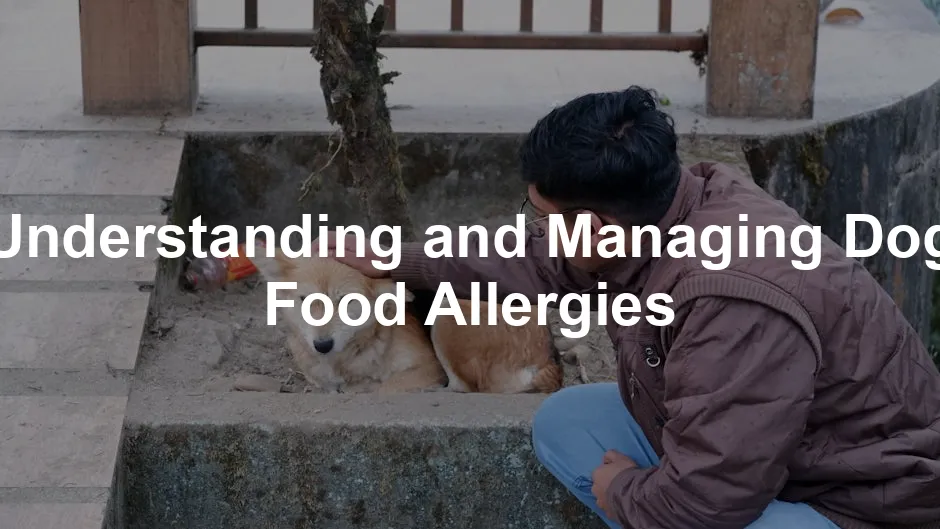Introduction
Dog food allergies are becoming more common among pet owners. As our furry friends navigate their diets, awareness grows around their health issues. It’s crucial to differentiate food allergies from food intolerances. Allergies involve the immune system’s overreaction, while intolerances are digestive issues without immune involvement. This article aims to provide a clear understanding of dog food allergies. We’ll cover how to identify, diagnose, and manage these allergies effectively. By equipping yourself with this knowledge, you’ll help your pup live a happier and healthier life.
If you’re looking for a reliable food option, consider Blue Buffalo Basics Limited Ingredient Diet Dog Food. This hypoallergenic option is perfect for dogs with sensitivities, helping them maintain a healthy diet without the risk of allergens.
Understanding Dog Food Allergies
What is a Food Allergy?
A food allergy is an exaggerated response from your dog’s immune system. When your dog eats a particular food, their immune system mistakenly identifies it as harmful. This triggers the production of antibodies against the offending protein. This process leads to various symptoms, which can range from mild discomfort to severe reactions. Unlike food intolerances, which are more about digestion, food allergies involve a full immune response.
In this context, you might want to consider Hill’s Science Diet Sensitive Stomach & Skin Dog Food. This formula is designed to support digestive health and skin sensitivity, making it a great choice for pups with allergies.
Types of Allergic Reactions
There are two main types of allergic reactions: immediate and delayed. An immediate reaction occurs within minutes to hours of eating the allergen. Symptoms may include swelling, vomiting, or hives. Delayed reactions, on the other hand, can take days to manifest. Common symptoms for both types include itching, gastrointestinal issues, and ear infections. Chronic ear infections often signal an underlying food allergy.
For those who want to take a proactive approach, consider Royal Canin Veterinary Diet Hydrolyzed Protein Adult HP Dog Food. This specially formulated diet helps manage food sensitivities and promotes healthy digestion.
Prevalence of Food Allergies in Dogs
Food allergies in dogs are not as prevalent as many may believe. Research shows that only about 0.2% of dogs actually suffer from food allergies. While it may seem high, other factors like environmental allergens and fleas often cause similar symptoms. Typically, food allergies develop in dogs between six months and three years of age. Certain breeds, such as Bulldogs and Retrievers, may be more prone to these allergies.
This understanding of dog food allergies is essential for pet owners. Recognizing the signs and knowing how to differentiate them from intolerances can lead to better health outcomes for your furry friend. By staying informed, you can make the right choices to keep your pup happy and healthy. And speaking of choices, if you’re looking for a limited ingredient option, check out Zignature Limited Ingredient Formula Dog Food. It’s a great choice for dogs with sensitivities.

Common Allergenic Foods
Most Common Allergens
When it comes to dog food allergies, certain ingredients take the cake—well, not literally! Here’s a rundown of the most common culprits:
- Beef: This protein is often a go-to for many dog foods. However, it’s also one of the top allergens. Dogs can develop a sensitivity over time, leading to issues if they consume it regularly.
- Chicken: Another popular protein, chicken is frequently found in many commercial dog foods. Unfortunately, it’s also a common allergen. If your dog has been feasting on chicken, it might be time to reconsider.
- Dairy: While some dogs can tolerate dairy, many cannot. Lactose intolerance is common in our furry friends, leading to digestive woes and skin irritation.
- Soy: Often used as a protein source, soy is another ingredient that can trigger allergy symptoms in sensitive pups. If your dog is allergic, it’s time to toss those soy-based foods.
- Wheat: This common grain can cause reactions in dogs, leading to itchy skin and gastrointestinal issues. It’s wise to look for grain-free options if your dog shows signs of allergy.
These ingredients are prevalent in dog foods mainly because they are cost-effective and widely accepted as good protein sources. However, their ubiquity can also lead to increased exposure—hence the allergies! And while you’re at it, consider switching to a Merrick Limited Ingredient Diet Dog Food. It’s packed with quality ingredients and great for sensitive stomachs!

Understanding Food Intolerances
Food intolerances often get mixed up with allergies, but they’re not the same. An intolerance occurs when your dog’s digestive system struggles to process certain ingredients. This doesn’t involve the immune system like allergies do. Symptoms of food intolerance can be sneaky and include:
- Gastrointestinal Issues: This could mean bloating, gas, or diarrhea. If your dog is experiencing any of these, it may be due to an intolerance.
- Skin Reactions: Dogs may develop rashes or chronic itching, similar to allergies, but without the immune response.
Common sources of food intolerance include dairy, certain grains, and even specific proteins. Unlike allergies, intolerances may manifest on the first exposure to a problematic ingredient. So, keep a watchful eye on your furry friend’s behavior and eating habits!

Understanding these distinctions is key. With the right knowledge, you can tailor your dog’s diet to keep them happy, healthy, and itch-free! For instance, if you’re considering limited ingredient options, you might want to check out Taste of the Wild High Prairie Canine Recipe. It’s a nutritious choice that many dogs love!
Diagnosing Dog Food Allergies
Veterinary Consultation
When it comes to diagnosing dog food allergies, a veterinarian is your best ally. Why? Because not all sneezes and scratches are caused by food allergies. A vet can help distinguish between food allergies and other issues, like environmental allergies or skin infections. An accurate diagnosis is crucial for effective management. Vets will often conduct a physical examination and take a thorough history of your dog’s symptoms and diet. This information can pinpoint potential allergens. Remember, you wouldn’t want to play the guessing game with your dog’s health!

Diagnostic Methods
Diagnosing food allergies involves several methods, each with its own significance.
- Elimination Diet: This method is like a culinary detective story! You’ll strip your dog’s diet down to the bare essentials—one novel protein and one carbohydrate that your pup hasn’t eaten before. This diet usually lasts 8-12 weeks. If your dog’s symptoms improve during this period, it’s likely you’ve identified the offending ingredient. If symptoms return upon reintroducing foods, bingo! You’ve found the culprit.
- Allergy Testing: There are two main types of allergy testing: skin tests and blood tests. Skin tests involve injecting potential allergens into the skin and observing reactions. Blood tests measure the presence of specific antibodies in response to allergens. However, these tests can sometimes yield false positives or negatives. They’re useful but not foolproof, so always consult your vet to interpret results accurately.
- Monitoring Symptoms: Keeping a diary of your dog’s food intake and symptoms is invaluable. Jot down every meal, treat, and any odd behavior—like that weird dance they do after eating! Tracking symptoms helps identify patterns and can provide your vet with essential information. This diary can be a game-changer in narrowing down the specific food causing trouble.
In conclusion, diagnosing dog food allergies requires a collaborative effort between you and your veterinarian. With the right tools and teamwork, you can uncover the mystery behind your dog’s pesky symptoms, leading to a happier, healthier pup!

Managing Dog Food Allergies
Dietary Changes
Managing dog food allergies starts with dietary changes. It’s time to be a food detective! A hypoallergenic diet is often recommended. These diets contain limited ingredients, which minimizes the chance of triggering an allergic reaction. Look for options with novel protein sources—think kangaroo or venison. These proteins are less likely to have been previously consumed, reducing the risk of reactions.
Also, consider limited ingredient diets. These contain just a few key ingredients, making it easier to identify what works for your dog. It’s like a simplified menu—no more confusing options! Regularly check labels to ensure the food remains free of allergens. Speaking of which, Natural Balance L.I.D. Limited Ingredient Diets Dog Food is a fantastic choice that simplifies your pup’s diet.

Supplements and Medications
In addition to dietary changes, supplements and medications can be beneficial. Probiotics are fantastic for gut health, which is crucial for dogs with food allergies. A healthy gut can make a significant difference in how well your dog tolerates new foods. Consider adding Probiotics for Dogs – PetVitalityPRO to your dog’s routine for added digestive support.
Omega fatty acids are another great addition. They help reduce inflammation and improve skin health—goodbye, itchy coat! You can find quality options like Omega-3 Fish Oil for Dogs to support your dog’s skin and coat health.
Medications may also be necessary, especially during flare-ups. Antihistamines can alleviate itching, while corticosteroids may help manage inflammation. Always consult your vet before starting any medication. They can provide the best recommendations tailored to your pup’s specific needs.
With the right approach to managing food allergies, your dog can enjoy a happier, healthier life. By making thoughtful dietary changes and considering supplements or medications, you’ll be well on your way to ensuring your furry friend is comfortable and thriving!

Environmental Management
Managing dog food allergies isn’t just about diet; it also involves creating a safe home environment. Here are some tips to reduce your pup’s exposure to allergens:
- Regular Cleaning: Dust and vacuum frequently. This helps remove allergens like dust mites and pet dander. A good rule of thumb? If you can see it, your dog can probably sniff it out too!
- Wash Dog Bedding: Toss your dog’s bedding in the wash weekly. Use hot water to eliminate allergens lurking in those cozy spots. Your pooch will appreciate the fresh digs!
- Air Purifiers: Invest in LEVOIT HEPA Air Purifier. These devices capture airborne allergens, providing your dog with cleaner air to breathe. It’s like giving your home a spa day!
- Keep Food in Sealed Containers: Store dog food in airtight containers. This prevents contamination from pests and helps maintain freshness. Because let’s face it, no one wants stale kibble!
- Limit Outdoor Exposure: During peak pollen seasons, limit your dog’s time outside. A quick bathroom break is fine, but prolonged exposure can lead to itchy consequences.
Regular grooming and bathing are essential in managing allergies. Here’s why:
- Grooming Routine: Brush your dog regularly to remove loose fur and dander. This reduces allergens in your home and keeps your dog’s coat healthy and shiny. Plus, who doesn’t love a good fur-fest?
- Bathing: Bathe your dog every few weeks using Vet’s Best Hypoallergenic Dog Shampoo. This helps to wash away allergens clinging to their skin and coat. It’s like a mini spa day—just without the cucumber slices.
So remember, while changing your dog’s diet is crucial, environmental management is just as important. Creating a clean, safe space for your furry friend can significantly alleviate allergy symptoms and help them live a happier, itch-free life.

Conclusion
Understanding and managing dog food allergies is crucial for your pet’s well-being. Allergies can lead to discomfort, health issues, and a lower quality of life for your furry friend. Recognizing symptoms early can make a significant difference. Remember, a proper diagnosis is vital, and consulting with a veterinarian is the best course of action. They can guide you through diagnostic tests and help create a tailored management plan.
Maintaining a healthy diet is essential. Novel proteins and limited ingredient diets can help prevent allergic reactions. Your dog’s happiness and health depend on your vigilance. Stay informed, keep a close eye on their reactions to new foods, and ensure regular vet check-ups. A little attention goes a long way in ensuring your pet lives a healthy, happy life! And don’t forget, for those outdoor adventures, consider getting a Dog Life Jacket for Safety. It’s a must-have for water-loving pups!

FAQs
What are the main differences between dog food allergies and intolerances?
Dog food allergies result from the immune system reacting to specific proteins, leading to symptoms like itching, vomiting, and diarrhea. In contrast, food intolerances involve digestive issues, often without immune involvement. Symptoms may include gas, bloating, and diarrhea, appearing immediately after eating the offending ingredient.
How long do I need to conduct an elimination diet?
An elimination diet typically lasts between 8 to 12 weeks. During this time, your dog should consume a limited ingredient diet with a novel protein and carbohydrate that they’ve never eaten before. It’s essential to avoid any other treats or food to ensure accurate results.
Can food allergies develop over time?
Yes, food allergies can develop at any age, even in dogs that have previously eaten a particular food without issues. Over time, continued exposure to an allergenic ingredient can lead to a hypersensitive immune response.
Is there a cure for dog food allergies?
Currently, there is no cure for dog food allergies. The most effective management strategy is to avoid the offending food entirely. This may involve switching to a hypoallergenic diet or finding foods that contain novel proteins.
What should I do if my dog has an allergic reaction?
If you suspect your dog is having an allergic reaction, contact your veterinarian immediately. Symptoms like swelling, difficulty breathing, or severe vomiting are emergencies. They may require immediate treatment, such as antihistamines or corticosteroids, to alleviate symptoms and prevent complications.
For comprehensive insights on understanding and managing dog food allergies, check out our detailed guide.
Please let us know what you think about our content by leaving a comment down below!
Thank you for reading till here 🙂
All images from Pexels





